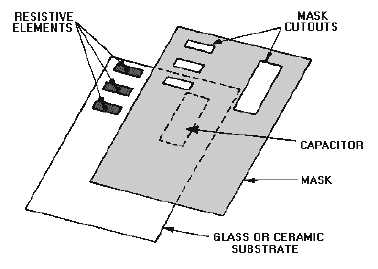1-17
Figure 1-17.—Cathode-sputtering mask.
Finely polished glass, glazed ceramic, and oxidized silicon have been used as substrate materials for
thin films. A number of materials, including nichrome, a compound of silicon oxide and chromium
cermets, tantalum, and titanium, have been used for thin-film resistors. Nichrome is the most widely used.
The process for producing thin-film capacitors involves deposition of a bottom electrode, a
dielectric, and finally a top electrode. The most commonly used dielectric materials are silicon monoxide
and silicon dioxide.
Thick Film
Thick films are produced by screening patterns of conducting and insulating materials on ceramic
substrates. A thick film is a film of material with a thickness that is at least 10 times greater than the mean
free path of an electron in that material, or approximately 0.001 centimeter. The technique is used to
produce only passive elements, such as resistors and capacitors.
PROCEDURES.—One procedure used in fabricating a thick film is to produce a series of stencils
called SCREENS. The screens are placed on the substrate and appropriate conducting or insulating
materials are wiped across the screen. Once the conducting or insulating material has been applied, the
screens are removed and the formulations are fired at temperatures above 600 degrees Celsius. This
process forms alloys that are permanently bonded to the insulating substrate. To a limited extent, the
characteristics of the film can be controlled by the firing temperature and length of firing time.
RESISTORS.—Thick-film resistance values can be held to a tolerance of
10 percent. Closer
tolerances are obtained by trimming each resistor after fabrication. Hundreds of different cermet
formulations are used to produce a wide range of component parameters. For example, the material used
for a 10-ohm-per-square resistor is quite different from that used for a 100-kilohm-per-square resistor.
CAPACITORS AND RESISTOR-CAPACITOR NETWORKS.—Capacitors are formed by a
sequence of screenings and firings. Capacitors in this case consist of a bottom plate, intraconnections, a
dielectric, and a top plate. For resistor-capacitor networks, the next step would be to deposit the resistor
material through the screen. The final step is screening and firing of a glass enclosure to seal the unit.

